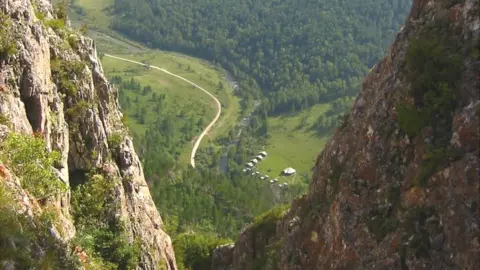Cave girl was half Neanderthal, half Denisovan
 B Viola, MPI-EVA
B Viola, MPI-EVAOnce upon a time, two early humans of different ancestry met at a cave in Russia.
Some 50,000 years later, scientists have confirmed that they had a daughter together.
DNA extracted from bone fragments found in the cave show the girl was the offspring of a Neanderthal mother and a Denisovan father.
The discovery, reported in Nature, gives a rare insight into the lives of our closest ancient human relatives.
Neanderthals and Denisovans were humans like us, but belonged to different species.
"We knew from previous studies that Neanderthals and Denisovans must have occasionally had children together," says Viviane Slon, researcher at the Max Planck Institute for Evolutionary Anthropology (MPI-EVA) in Leipzig, Germany.
"But I never thought we would be so lucky as to find an actual offspring of the two groups."
Is everyone part Neanderthal?
Present-day, non-African humans have a small proportion of their DNA that comes from Neanderthals.
Some other non-African populations, depending on where they live, also have a fraction of their DNA that comes from an Asian people known as Denisovans.
 B Viola, MPI-EVA
B Viola, MPI-EVAThe fact the genes have been passed down the generations shows that interbreeding must have happened.
However, the only known site where fossil evidence of both Denisovans and Neanderthals has been found is at Denisova cave in the Altai Mountains of Siberia.
Furthermore, fewer than 20 so-called archaic humans (those belonging to species other than our own, Homo sapiens) have had their genomes sequenced.
"Out of this very little number we find one individual that has half-and-half mixed ancestry, " Dr Slon told BBC News.
When other studies are taken into account, "you start to get a picture that over all of our evolutionary history humans always mixed with each other".
When and where did Neanderthals and Denisovans live?
Neanderthals and Denisovans are known to have overlapped in time in Eurasia.
The two groups lived until about 40,000 years ago; Neanderthals in the west and Denisovans in the east.
As Neanderthals migrated eastwards, they may have encountered Denisovans at times, as well as early modern humans.
"Neanderthals and Denisovans may not have had many opportunities to meet," says Svante Pääbo, director of MPI-EVA.
"But when they did, they must have mated frequently - much more so than we previously thought."
What do we know about the girl and her family?
The girl's story has been pieced together from a single fragment of bone found in the Denisova cave by Russian archaeologists several years ago.
 B Viola, MPI-EVA
B Viola, MPI-EVAIt was brought to Leipzig for genetic analysis.
"The fragment is part of a long bone, and we can estimate that this individual was at least 13 years old," says Bence Viola of the University of Toronto.
The researchers deduced that the girl's mother was genetically closer to Neanderthals who lived in western Europe than to a Neanderthal individual who lived earlier in Denisova Cave.
This shows that Neanderthals migrated between western and eastern Europe and Asia tens of thousands of years before they died out.
Genetic tests also revealed that the Denisovan father had at least one Neanderthal ancestor further back in his family tree.
Follow Helen on Twitter.